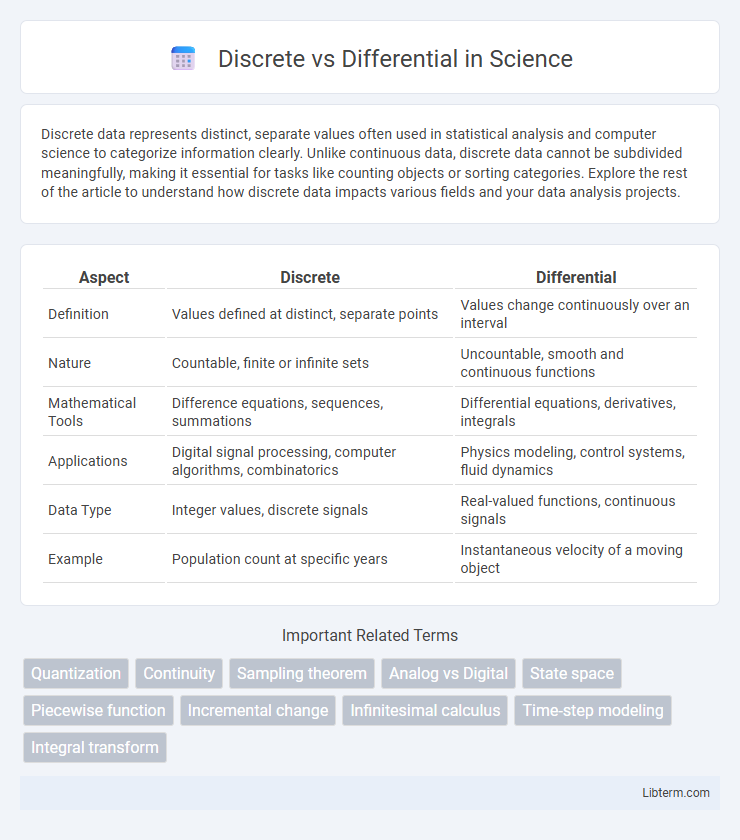Discrete data represents distinct, separate values often used in statistical analysis and computer science to categorize information clearly. Unlike continuous data, discrete data cannot be subdivided meaningfully, making it essential for tasks like counting objects or sorting categories. Explore the rest of the article to understand how discrete data impacts various fields and your data analysis projects.
Table of Comparison
| Aspect | Discrete | Differential |
|---|---|---|
| Definition | Values defined at distinct, separate points | Values change continuously over an interval |
| Nature | Countable, finite or infinite sets | Uncountable, smooth and continuous functions |
| Mathematical Tools | Difference equations, sequences, summations | Differential equations, derivatives, integrals |
| Applications | Digital signal processing, computer algorithms, combinatorics | Physics modeling, control systems, fluid dynamics |
| Data Type | Integer values, discrete signals | Real-valued functions, continuous signals |
| Example | Population count at specific years | Instantaneous velocity of a moving object |
Introduction to Discrete and Differential Concepts
Discrete concepts involve distinct, separate values often represented as integers or countable sets, essential in digital systems and computer science. Differential concepts relate to continuous changes and rates of variation, fundamental in calculus and modeling real-world physical phenomena. Understanding the distinction between discrete and differential approaches enables effective problem-solving across mathematics, engineering, and data analysis domains.
Understanding Discrete Systems
Discrete systems operate with distinct, separate values often represented by sequences or digital signals, making them ideal for digital computing and signal processing applications. Understanding discrete systems involves analyzing how data points change at specific intervals, allowing for precise modeling of real-world phenomena like population growth or economic trends. Mastery of discrete system concepts enables the design and implementation of efficient algorithms, control systems, and communication protocols in modern technology.
Overview of Differential Systems
Differential systems model continuous-time dynamics using differential equations that describe how system states evolve with respect to time derivatives, capturing natural phenomena in engineering and physics. These systems are characterized by smooth state trajectories, allowing precise analysis of stability, control, and response through methods like Laplace transforms and phase-space representations. Unlike discrete systems with stepwise transitions, differential systems operate over an uncountable infinite domain, providing a fundamental framework for understanding continuous processes in control theory and dynamic system analysis.
Key Differences Between Discrete and Differential Approaches
Discrete approaches analyze distinct, separate data points or states, often used in digital signal processing and time-series analysis, whereas differential methods focus on continuous change rates and derivatives, fundamental in calculus and dynamic systems modeling. Discrete models operate on sequences or sets with finite elements, while differential models handle smooth functions defined over intervals, enabling precise predictions of system behavior over time. The choice between discrete and differential approaches depends on the nature of the data and the mathematical framework required for accurate and efficient problem-solving.
Mathematical Representations: Discrete vs Differential
Discrete mathematical representations use sequences or sets of distinct values defined at specific intervals, often modeled with difference equations to describe system behavior step-by-step. Differential representations employ continuous functions and derivatives, expressed through differential equations that capture instantaneous rates of change and dynamics in continuous time. Understanding the distinction between discrete difference equations and continuous differential equations is crucial for accurately modeling systems in digital signal processing, control theory, and applied mathematics.
Applications of Discrete Methods
Discrete methods are widely applied in computer science for algorithm design, data structures, and network analysis, enabling efficient problem-solving in digital systems. These methods are critical in cryptography, coding theory, and combinatorial optimization, supporting secure communication and resource allocation. Additionally, discrete mathematics underpins database theory, automata theory, and digital circuit design, fostering advances in software engineering and hardware development.
Applications of Differential Methods
Differential methods play a crucial role in engineering and physics, enabling the analysis and modeling of dynamic systems through differential equations. Applications include control systems design, fluid dynamics simulation, and electrical circuit analysis where continuous change over time is crucial. These methods provide precise predictions of system behavior, optimizing performance in aerodynamics, signal processing, and heat transfer problems.
Advantages and Limitations of Discrete Systems
Discrete systems offer advantages such as ease of implementation in digital computers, straightforward storage and manipulation of data, and robustness to noise due to quantized states. Limitations include reduced accuracy from finite resolution, potential aliasing effects during sampling, and difficulties in modeling inherently continuous phenomena. These constraints necessitate careful design to balance system complexity and performance in digital signal processing and control applications.
Benefits and Drawbacks of Differential Systems
Differential systems offer continuous-time signal processing, providing higher accuracy and smoother control responses in dynamic environments compared to discrete systems that operate on sampled data. The main benefits of differential systems include reduced aliasing errors and better handling of rapid signal changes, improving system stability and responsiveness. However, differential systems are often more complex to implement, require continuous monitoring, and can be sensitive to noise, which may lead to increased design and maintenance costs.
Choosing Between Discrete and Differential: Practical Considerations
Choosing between discrete and differential approaches depends on the nature of the data and the specific application requirements. Discrete methods are ideal for handling distinct, separate values such as digital signals or categorical data, while differential methods excel in analyzing continuous changes and rates, often used in control systems and signal processing. Practical considerations include computational complexity, real-time processing needs, and accuracy in representing gradual variations versus capturing distinct events.
Discrete Infographic

 libterm.com
libterm.com